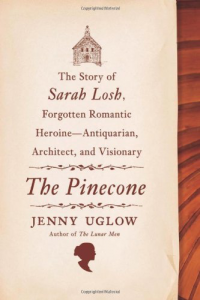Review of The Pinecone: The Story of Sarah Losh
 The Pinecone: The Story of Sarah Losh, Forgotten Romantic Heroine—Antiquarian, Architect, and Visionary by Jenny Uglow is a gentle and enjoyable read that can be a chore if you prefer to read biographies of the great movers and shakers of history.
The Pinecone: The Story of Sarah Losh, Forgotten Romantic Heroine—Antiquarian, Architect, and Visionary by Jenny Uglow is a gentle and enjoyable read that can be a chore if you prefer to read biographies of the great movers and shakers of history.
Well, not a chore but more a sense of frustration if you’re expecting some great revelation or some great struggle or some great achievement. Instead, Sarah Losh’s great revelation is to be happy with yourself and your family and friends; her great achievement is a small, odd, almost windowless church in Wreay, Cumbria; and her only struggles the sadness that affects any family—principally death that comes too early. Uglow’s book movingly captures this by chronicling the fortunes of her family that combined land (upon the death of her father, Sarah inherited the considerable estate and Georgian mansion of Woodside) and industry (the Losh brothers invested in and developed alkali and later iron works near Newcastle). Twin sources of income kept the Losh family comfortable despite a few financial setbacks and allowed Sarah to fulfill the early dream of Emma Woodhouse to never need to marry.
In fact, Sarah and Katharine Losh remained unmarried sisters until their deaths (Katharine died in 1835 and Sarah in 1853) and for all that is recorded and represented in the book, neither regretted their life choices. Apparently Sarah’s writings are lost, but from her extensive family, her numerous good works and her varied interests, I have to believe she led a happy life. Any Janeite reading this book cannot help but think of Jane and Cassandra Austen and the happiness those sisters derived from one another. The mausoleum for and the sculpture of Katharine that Sarah built and commissioned echoes the grief Cassandra expressed upon the death of Jane and which Uglow quotes: “I have lost a treasure, such a sister, such a friend as can never be surpassed, — she was the sun of my life, the gilder of every pleasure, the soother of every sorrow.”

Possibly because we have none of Sarah’s writings, much of the book explores Sarah’s life through the exploits of her family. Her reform-minded uncle James was a much respected attorney whose funeral in Newcastle was attended by a quarter mile of mourners, including members of literary and philosophical and anti-slavery societies. Her uncle William began the alkali works with her father. Uncle George was the Swedish vice consul in Newcastle but ultimately he proved not as shrewd as his brothers.
We do see Sarah as a dutiful daughter and niece and we are shown details of her continental trip, especially her visit to Italy that informed the rest of her life. We do know she was very cognizant of the politics and science of the day, especially geology. It’s easy to see from Uglow’s book how Sarah became the romantic that she was.
Sarah’s great achievement, as mentioned before, is the small church of St. Mary’s in Wreay. It was almost in ruin until a major restoration in 2006 and it’s still an odd legacy. Sarah, who had a free hand in designing and building the church (she essentially paid for it herself), followed her own principles and beliefs and so created a church without overt religious symbols in a Roman basilica style. She put her personal stamp on it to the extent that she even carved the font and decorated it with water lilies, pomegranates, grapevines and dragonflies. The whole church, in fact, had odd decorations that spoke of nature and history rather than the spiritual. There’s a winged turtle/gargoyle on the outside of the church, fossils carved into window coverings and an arrow embedded in a wall such that only the shaft and flights are visible.
Unfortunately, either the pictures in the book do not do the church justice or else the church is an intimate achievement that is best experienced first hand. Regardless, it’s still a remarkable achievement.


It’s amazing that at the time, a woman could conceive, design and build with her own hands a church, much less do it in a style that predates and predicts the Arts and Crafts movement of the early twentieth century, but it’s still not a triumph of the will. Sarah Losh was a wealthy woman and the inheritor of generations of respect for her family name. It was no surprise that a Losh should say something should be done and that later it was agreed by all that it should be done. So don’t read this biography expecting an example of feminine empowerment or a grand architectural statement. Instead read this as an example of a life well lead, of a mind open to new ideas in a time of great change and come away with a sense that one could have no better model for a happy life.
Oh, about that initial comment about the book being a chore: I kept expecting something more—that Losh would be revealed to be one of those movers and shakers and it took a while before I realized the scope of the book and of her life. (The family were friends of the Losh’s architectural achievements, after all, include a village school, her sister’s mausoleum and the church, which together hardly have the footprint of a modern day McMansion. It wasn’t until I finished the book that I appreciated what I had read.
As an extra treat, here’s Jenny Uglow talking about her book and as a bonus, A.N. Wilson talking about his book, The Potter’s Hand.
